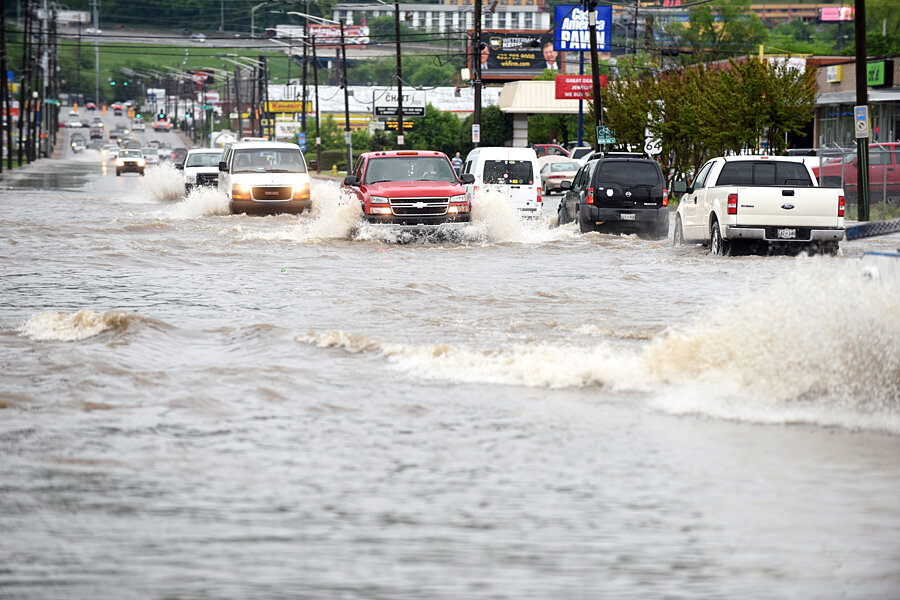Despite more risks, humanity is less vulnerable to floods, study finds
Loading...
Humanity's vulnerability to floods has eased, despite increases in population and in the value of assets located in flood-prone areas, according to a new study.
The analysis notes a persistent vulnerability gap between rich and poor countries. But the gap has closed considerably, largely because developing countries have taken steps to reducing fatalities and economic losses from floods.
One striking example: In 1999 and again in 2013, similarly powerful tropical cyclones struck in the same general area along India's east coast. The 2013 storm was the second strongest on record to hit the subcontinent, after the '99 cyclone. In 1999, some 10,000 people lost their lives – compared with fewer than 50 reported fatalities for the 2013 storm. The difference: heavy post-'99 investments in storm shelters and early-warning systems.
The '99 storm also helped highlight the protection that natural barriers can afford to storm-surge flooding – barriers such as healthy stands of mangroves along the coast.
Averaged globally, fatalities eased from about 70 per 1 million people in flood-prone areas to about 40 per 1 million people between 1990 and 2010, although among the poorest countries, fatalities still ranged from 300 to 1,000 per million.
The average value of flood damage globally as a proportion of gross domestic product (GDP) shrank from about 10 percent to 6 percent during the same period, according to the analysis.
In 1990, economic losses in developing countries ran some 800 percent higher than the losses in developed countries. By 2010, that gap had narrowed to 160 percent.
Increases in per capita income have driven these trends, according to a team led by Brenden Jongman, a researcher with the Institute for Environmental Studies at VU University in Amsterdam and the lead author of the study, published Monday in the online edition of Proceedings of the National Academy of Sciences.
These results are "very encouraging," Dr. Jongman says. "It shows that things are not hopeless."
The team's work also points to the mutually reinforcing connections between improving economies and increased resilience to floods, he suggests.
The study appears on the heels of the Third UN World Conference on Disaster Risk Reduction, held in Sendai, Japan, at which representatives from 187 countries agreed to a new framework for reducing risks to natural hazards.
Countries agreed to several goals over the next 15 yeas, including substantial cuts in human and economic losses, and an increase in the number of countries with national and local strategies to reduce natural-disaster risks.
Yet adaptation aid to developing countries remains a contentious issue in global climate talks under the UN Framework Convention on Climate Change. By the end of the year, negotiators hope to have a new draft climate treaty in hand, including provisions for adaptation aid.
To build a base line for the analysis, Jongman's team needed a sense for flood hazards in the absence of any intentional flood protection. Jongman and colleagues fed daily climate data into a global hydrology model to build flood maps for the world's rivers. The maps showed the potential maximum flooding for each year in every country between 1980 to 2010 – the period for which the most complete data were available. The researchers added annual data on population density to estimate the number of people in harm's way and on per capita income as an indicator of economic assets.
To gauge changes in vulnerability, they compared the results with data on actual flood fatalities and economic losses using five-year running averages.
In addition to revealing the global decline in vulnerability, the team found no statistically significant increases in annual average maximum flood volume during that 30-year period. But between 1990 and 2010, the researchers did identify a small but statistically significant increase in volume, which "could potentially be a signal of climate change," they write in a formal description of the study.
While the trends in vulnerability are encouraging, the team cautions that as economies grow, and with the threat of more and more-intense floods from global warming, flood losses could increase dramatically unless additional measures to reduce vulnerability are undertaken.
Other research has shown that flood losses in the United States as a percentage of GDP have fallen by more than 75 percent since 1940, notes Roger Pielke Jr., a science-policy specialist at the University of Colorado at Boulder whose work has focused in part on tracking trends in climate-related disaster losses and factors that affect their impact on society.
Although the new global average figures are far less dramatic, the analysis and its wider scope are providing "some good news that collectively we are doing something right," he says.






